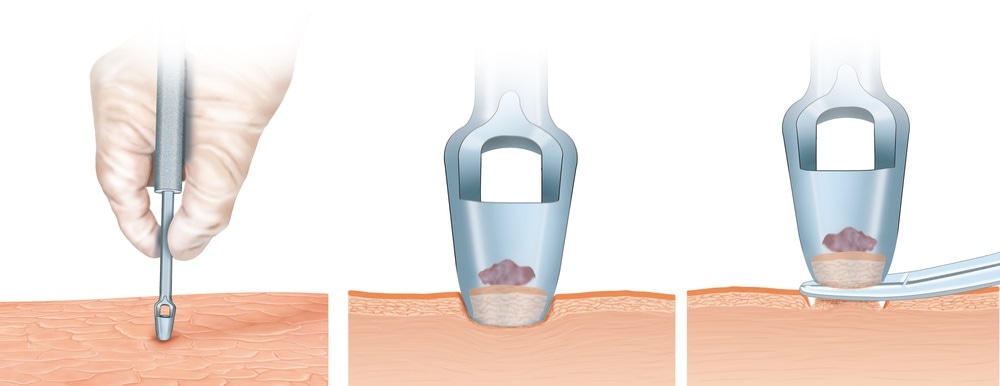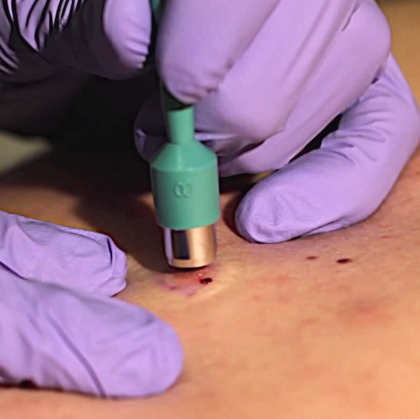What you need to know about Skin Biopsy
Contents
A skin biopsy is a procedure in which cells or skin samples are removed from the surface of the body to be tested. The sample taken from a skin biopsy is sent to a laboratory and examined by a pathologist under a microscope. By looking at the sample, the pathologist can diagnose or rule out skin cancer. In some cases, it can also be used to remove skin lesions.
A skin biopsy is needed to diagnose or to help treat skin conditions and diseases, including skin infection, warts, actinic keratosis, skin tags, suspicious moles or other growths, blistering skin disorders (such as bullous pemphigoid), inflammatory skin conditions (such dermatitis and psoriasis), and skin cancers (including melanoma, squamous cell carcinoma, and basal cell carcinoma).

What does the Procedure Involve?
Before the procedure, your doctor cleans the area of the skin to be biopsied. Your skin may be marked to outline the biopsy area. You will then be given a local anesthetic to numb the biopsy site.
How your doctor performs the procedure depends on the type of biopsy.
-
Shave biopsy – during this type of biopsy, your doctor uses a sharp tool, scalpel or double-edged razor to remove a small section of the top layers of your skin (epidermis and a portion of the dermis).
-
Punch biopsy – your doctor uses a circular instrument called punch in order to remove a small section of your skin, including the deeper layers (epidermis, dermis, as well as superficial fat).
-
Excisional biopsy – your doctor uses a small scalpel in order to remove an area of abnormal skin, which includes a portion of normal skin down to the fatty layer of skin. This type of biopsy can also be done to remove an entire lump, usually smaller lesions.
-
Incisional biopsy – a scalpel is used to remove a small sample of large lesions.
While a shave biopsy usually does not need stitches, punch biopsy, excisional biopsy, and incisional biopsy usually require stitches to close the wound as they involve cutting into the uppermost layer of fat underneath the skin.
How Long Should I Stay in the Area?
A skin biopsy usually takes around 15 minutes to complete. It is an outpatient procedure, so you can leave the hospital on the same day as your skin biopsy. However, since the results are available within several days or weeks, you need to stay in the area for at least 7 days following your biopsy. Once the result is available, you will need to attend a follow-up visit to discuss the results of the test with your doctor.
What’s the Recovery Time?
In general, you should rest as much as possible for the remainder of the day and go back to your normal activities the day after. However, you need to take it easy and avoid vigorous activities for a few days to avoid complications. How long it takes your biopsy site to heal depends upon the depth and size of the biopsy, which may take about 2 to 3 weeks.
What About Aftercare?
Following the biopsy, your doctor will give you aftercare instruction. Follow the instructions carefully for a quick and smooth recovery. You may experience some soreness on or around the biopsy site for a few days, but you can take Tylenol to relieve any discomfort. If you had stitches, make sure to keep the area clean. Try not to do any activities that might stretch the skin as it could enlarge the scar cause the wound to bleed.
What’s the Success Rate?
A skin biopsy is a safe and accurate method to diagnose skin conditions and diseases. The accuracy of shave biopsy is 97%, while a punch biopsy is shown to be 85% accurate. The result of a skin biopsy is highly dependent on the quality of the biopsy submitted. It is possible to miss the diagnosis of a skin tumor.
The result of your skin biopsy will include a diagnosis and a description of the skin condition. If the sample is found to be cancerous, the description will include information about how quickly the cancer cells are dividing, the thickness and margins of the tumor, presence of tiny tumors near the main tumor, as well as invasion of the tumor into a nerve, blood vessel, or lymph vessel.
While a skin biopsy is a generally safe procedure, complications can still occur. These include bleeding, bruising, infection, scarring, and allergic reaction to the anesthesia.
Are there Alternatives to Skin Biopsy?
A skin biopsy is needed to diagnose and treat skin conditions and diseases. There are currently no other alternatives to diagnose skin cancer and other serious skin conditions.
What Should You Expect Before and After the Procedure
Before a skin biopsy, your doctor may not know for sure the skin condition or disease you have. After the biopsy, your doctor will be able to diagnose or rule out skin cancer. This allows them to help create a treatment plan for you. If your doctor removed an entire lesion, then the biopsy may have also cured cancer.
For an in-depth analysis of a Skin Biopsy Procedure, watch this short video.
https://youtube.com/watch?v=lB5qd4RtsI0
To check prices or to book a Skin Biopsy Procedure, in Thailand or anywhere else in the world, head on over to MyMediTravel now!

